Organizational Change & Development: An Analysis of Hospitality Firms
VerifiedAdded on 2023/06/14
|15
|3511
|97
Report
AI Summary
This report explores organizational change and development within the hospitality industry, focusing on employee perceptions and the effectiveness of change management strategies. It details the methodology used, including interviews with employees from retail and hospitality organizations, and analyzes the findings through the lens of action research. The report critiques existing literature on managing change, considering factors such as acceptance of change, the change process itself, and theoretical models like Lewin's 3-stage model. The findings reveal varying levels of acceptance and resistance to change among employees, influenced by their positions and communication strategies. The report concludes by emphasizing the importance of strategic planning and effective communication in successfully implementing organizational changes within the competitive hospitality landscape. Desklib provides access to this report and many other resources for students.
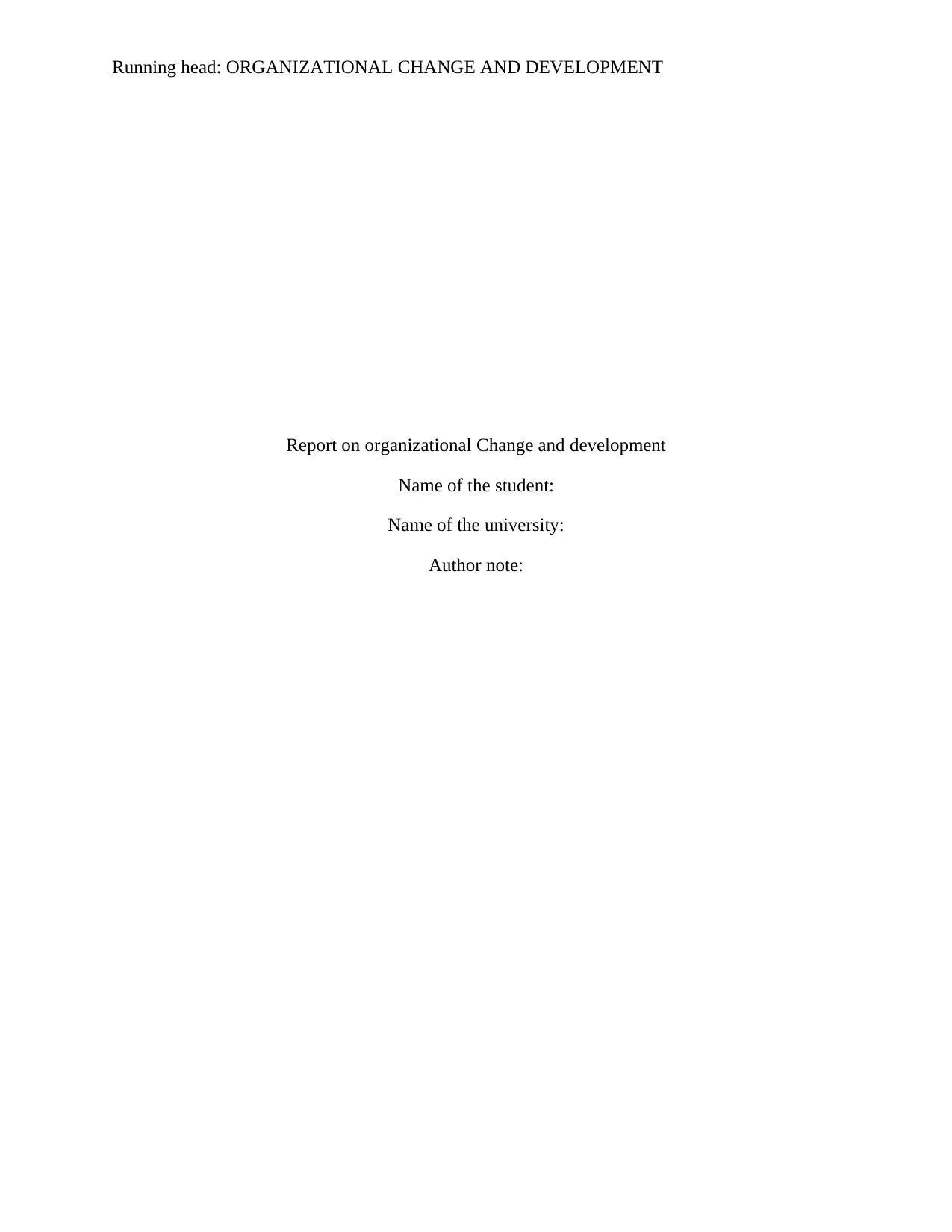
Running head: ORGANIZATIONAL CHANGE AND DEVELOPMENT
Report on organizational Change and development
Name of the student:
Name of the university:
Author note:
Report on organizational Change and development
Name of the student:
Name of the university:
Author note:
Paraphrase This Document
Need a fresh take? Get an instant paraphrase of this document with our AI Paraphraser
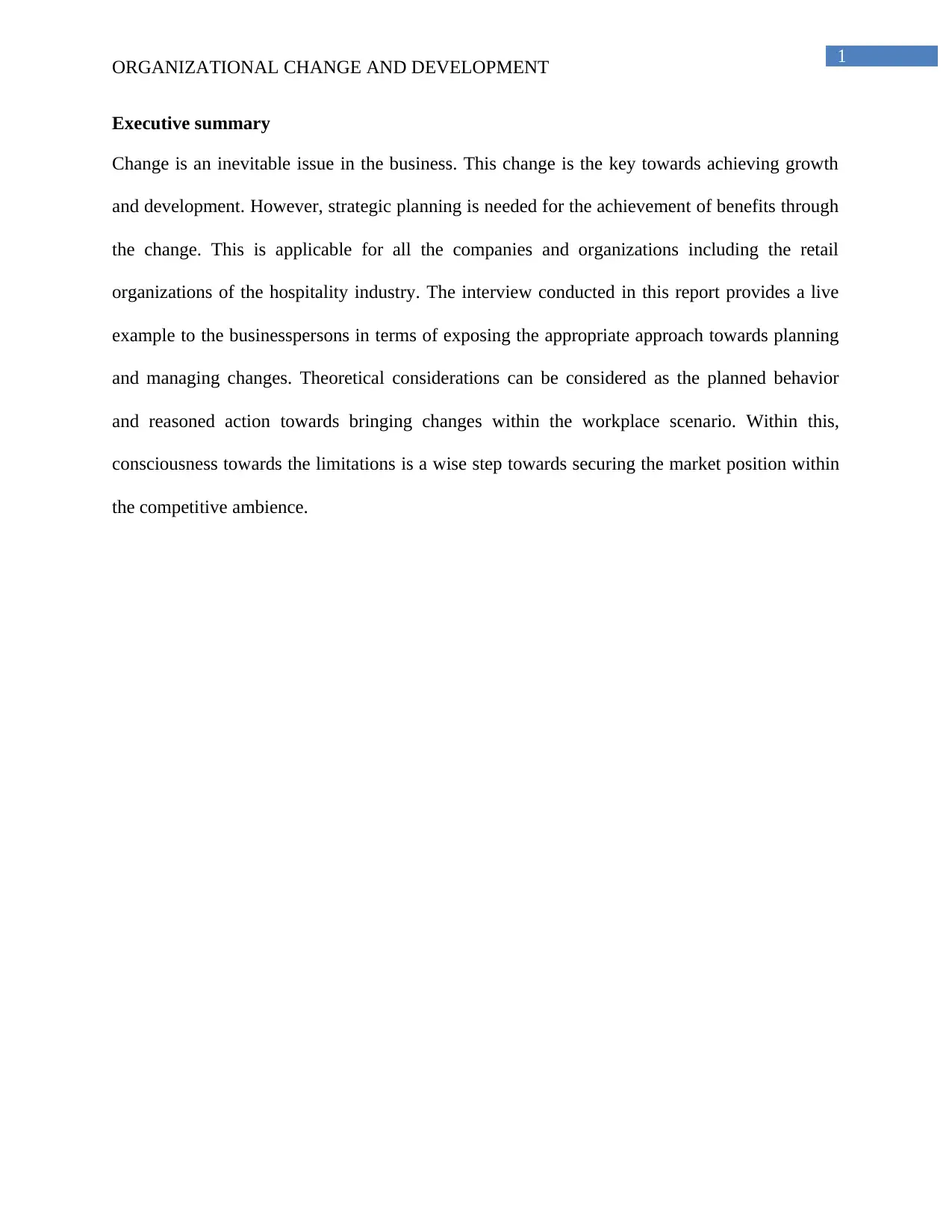
1
ORGANIZATIONAL CHANGE AND DEVELOPMENT
Executive summary
Change is an inevitable issue in the business. This change is the key towards achieving growth
and development. However, strategic planning is needed for the achievement of benefits through
the change. This is applicable for all the companies and organizations including the retail
organizations of the hospitality industry. The interview conducted in this report provides a live
example to the businesspersons in terms of exposing the appropriate approach towards planning
and managing changes. Theoretical considerations can be considered as the planned behavior
and reasoned action towards bringing changes within the workplace scenario. Within this,
consciousness towards the limitations is a wise step towards securing the market position within
the competitive ambience.
ORGANIZATIONAL CHANGE AND DEVELOPMENT
Executive summary
Change is an inevitable issue in the business. This change is the key towards achieving growth
and development. However, strategic planning is needed for the achievement of benefits through
the change. This is applicable for all the companies and organizations including the retail
organizations of the hospitality industry. The interview conducted in this report provides a live
example to the businesspersons in terms of exposing the appropriate approach towards planning
and managing changes. Theoretical considerations can be considered as the planned behavior
and reasoned action towards bringing changes within the workplace scenario. Within this,
consciousness towards the limitations is a wise step towards securing the market position within
the competitive ambience.
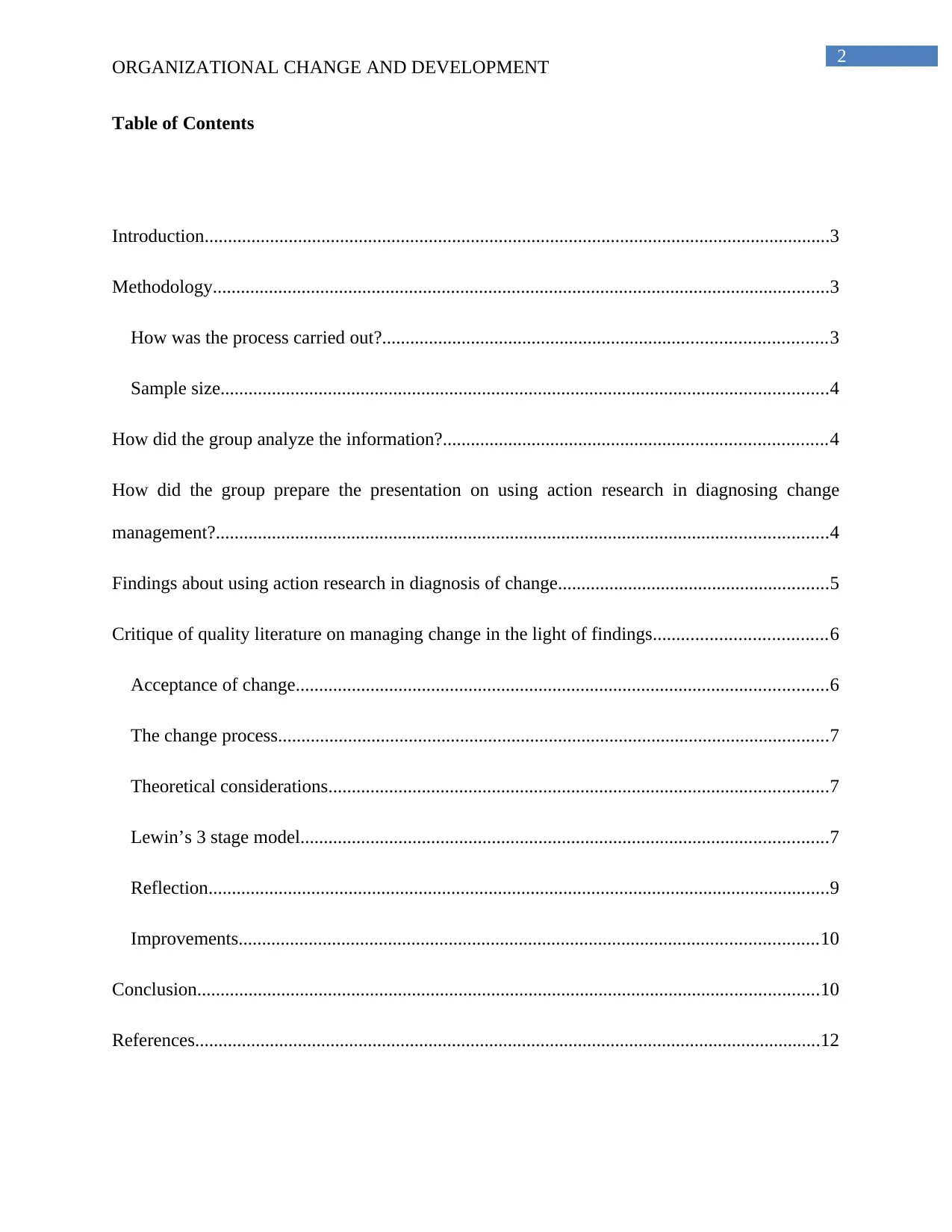
2
ORGANIZATIONAL CHANGE AND DEVELOPMENT
Table of Contents
Introduction......................................................................................................................................3
Methodology....................................................................................................................................3
How was the process carried out?...............................................................................................3
Sample size..................................................................................................................................4
How did the group analyze the information?..................................................................................4
How did the group prepare the presentation on using action research in diagnosing change
management?...................................................................................................................................4
Findings about using action research in diagnosis of change..........................................................5
Critique of quality literature on managing change in the light of findings.....................................6
Acceptance of change..................................................................................................................6
The change process......................................................................................................................7
Theoretical considerations...........................................................................................................7
Lewin’s 3 stage model.................................................................................................................7
Reflection.....................................................................................................................................9
Improvements............................................................................................................................10
Conclusion.....................................................................................................................................10
References......................................................................................................................................12
ORGANIZATIONAL CHANGE AND DEVELOPMENT
Table of Contents
Introduction......................................................................................................................................3
Methodology....................................................................................................................................3
How was the process carried out?...............................................................................................3
Sample size..................................................................................................................................4
How did the group analyze the information?..................................................................................4
How did the group prepare the presentation on using action research in diagnosing change
management?...................................................................................................................................4
Findings about using action research in diagnosis of change..........................................................5
Critique of quality literature on managing change in the light of findings.....................................6
Acceptance of change..................................................................................................................6
The change process......................................................................................................................7
Theoretical considerations...........................................................................................................7
Lewin’s 3 stage model.................................................................................................................7
Reflection.....................................................................................................................................9
Improvements............................................................................................................................10
Conclusion.....................................................................................................................................10
References......................................................................................................................................12
⊘ This is a preview!⊘
Do you want full access?
Subscribe today to unlock all pages.

Trusted by 1+ million students worldwide
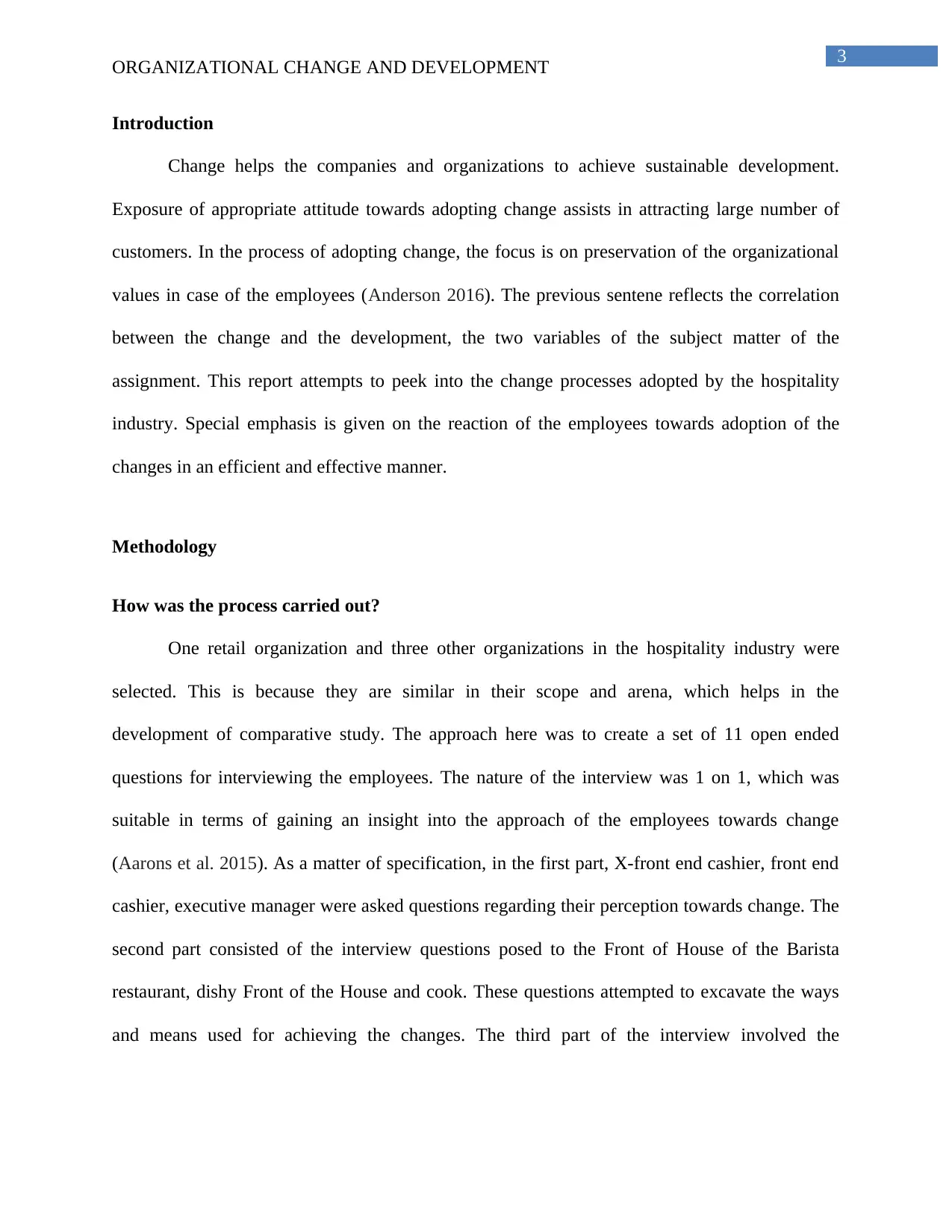
3
ORGANIZATIONAL CHANGE AND DEVELOPMENT
Introduction
Change helps the companies and organizations to achieve sustainable development.
Exposure of appropriate attitude towards adopting change assists in attracting large number of
customers. In the process of adopting change, the focus is on preservation of the organizational
values in case of the employees (Anderson 2016). The previous sentene reflects the correlation
between the change and the development, the two variables of the subject matter of the
assignment. This report attempts to peek into the change processes adopted by the hospitality
industry. Special emphasis is given on the reaction of the employees towards adoption of the
changes in an efficient and effective manner.
Methodology
How was the process carried out?
One retail organization and three other organizations in the hospitality industry were
selected. This is because they are similar in their scope and arena, which helps in the
development of comparative study. The approach here was to create a set of 11 open ended
questions for interviewing the employees. The nature of the interview was 1 on 1, which was
suitable in terms of gaining an insight into the approach of the employees towards change
(Aarons et al. 2015). As a matter of specification, in the first part, X-front end cashier, front end
cashier, executive manager were asked questions regarding their perception towards change. The
second part consisted of the interview questions posed to the Front of House of the Barista
restaurant, dishy Front of the House and cook. These questions attempted to excavate the ways
and means used for achieving the changes. The third part of the interview involved the
ORGANIZATIONAL CHANGE AND DEVELOPMENT
Introduction
Change helps the companies and organizations to achieve sustainable development.
Exposure of appropriate attitude towards adopting change assists in attracting large number of
customers. In the process of adopting change, the focus is on preservation of the organizational
values in case of the employees (Anderson 2016). The previous sentene reflects the correlation
between the change and the development, the two variables of the subject matter of the
assignment. This report attempts to peek into the change processes adopted by the hospitality
industry. Special emphasis is given on the reaction of the employees towards adoption of the
changes in an efficient and effective manner.
Methodology
How was the process carried out?
One retail organization and three other organizations in the hospitality industry were
selected. This is because they are similar in their scope and arena, which helps in the
development of comparative study. The approach here was to create a set of 11 open ended
questions for interviewing the employees. The nature of the interview was 1 on 1, which was
suitable in terms of gaining an insight into the approach of the employees towards change
(Aarons et al. 2015). As a matter of specification, in the first part, X-front end cashier, front end
cashier, executive manager were asked questions regarding their perception towards change. The
second part consisted of the interview questions posed to the Front of House of the Barista
restaurant, dishy Front of the House and cook. These questions attempted to excavate the ways
and means used for achieving the changes. The third part of the interview involved the
Paraphrase This Document
Need a fresh take? Get an instant paraphrase of this document with our AI Paraphraser
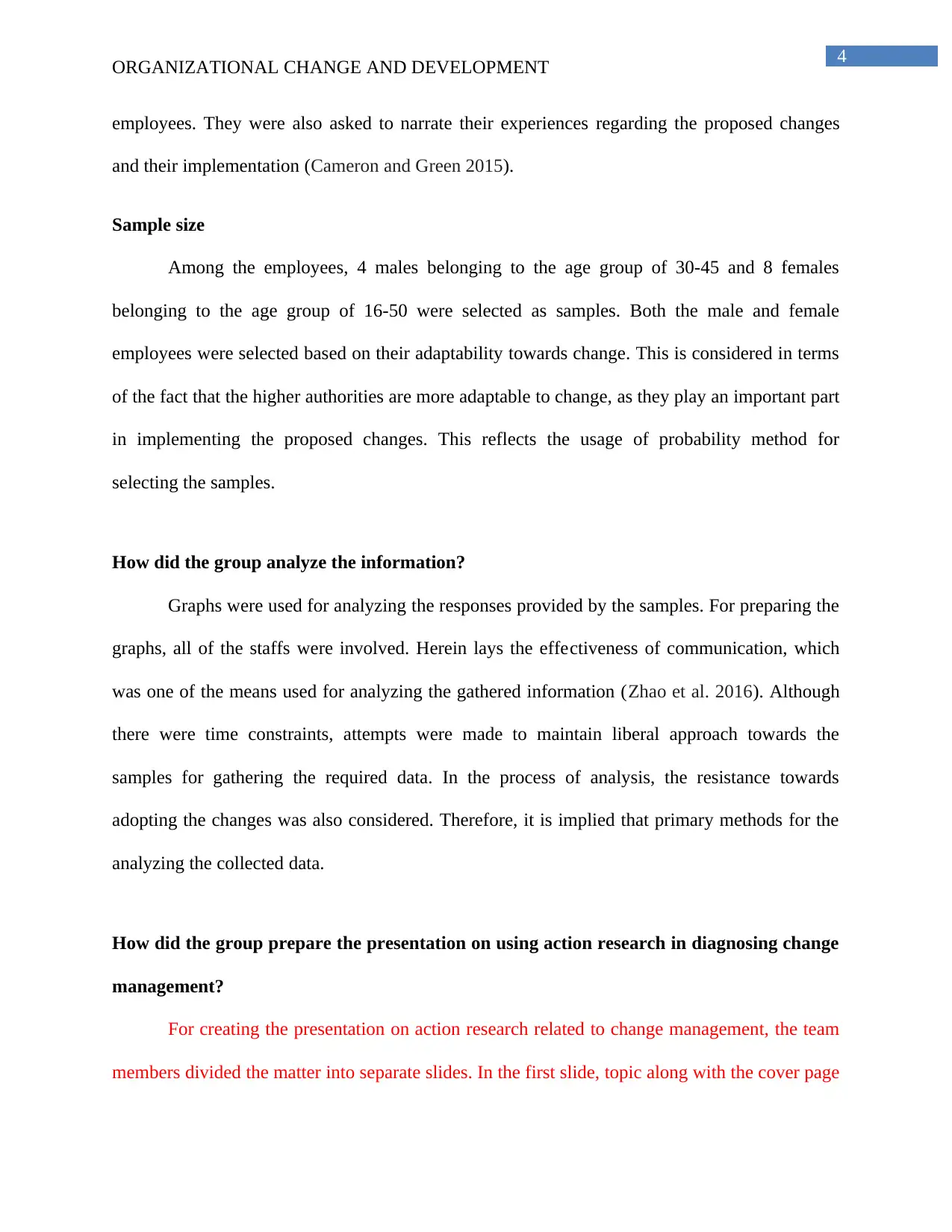
4
ORGANIZATIONAL CHANGE AND DEVELOPMENT
employees. They were also asked to narrate their experiences regarding the proposed changes
and their implementation (Cameron and Green 2015).
Sample size
Among the employees, 4 males belonging to the age group of 30-45 and 8 females
belonging to the age group of 16-50 were selected as samples. Both the male and female
employees were selected based on their adaptability towards change. This is considered in terms
of the fact that the higher authorities are more adaptable to change, as they play an important part
in implementing the proposed changes. This reflects the usage of probability method for
selecting the samples.
How did the group analyze the information?
Graphs were used for analyzing the responses provided by the samples. For preparing the
graphs, all of the staffs were involved. Herein lays the effectiveness of communication, which
was one of the means used for analyzing the gathered information (Zhao et al. 2016). Although
there were time constraints, attempts were made to maintain liberal approach towards the
samples for gathering the required data. In the process of analysis, the resistance towards
adopting the changes was also considered. Therefore, it is implied that primary methods for the
analyzing the collected data.
How did the group prepare the presentation on using action research in diagnosing change
management?
For creating the presentation on action research related to change management, the team
members divided the matter into separate slides. In the first slide, topic along with the cover page
ORGANIZATIONAL CHANGE AND DEVELOPMENT
employees. They were also asked to narrate their experiences regarding the proposed changes
and their implementation (Cameron and Green 2015).
Sample size
Among the employees, 4 males belonging to the age group of 30-45 and 8 females
belonging to the age group of 16-50 were selected as samples. Both the male and female
employees were selected based on their adaptability towards change. This is considered in terms
of the fact that the higher authorities are more adaptable to change, as they play an important part
in implementing the proposed changes. This reflects the usage of probability method for
selecting the samples.
How did the group analyze the information?
Graphs were used for analyzing the responses provided by the samples. For preparing the
graphs, all of the staffs were involved. Herein lays the effectiveness of communication, which
was one of the means used for analyzing the gathered information (Zhao et al. 2016). Although
there were time constraints, attempts were made to maintain liberal approach towards the
samples for gathering the required data. In the process of analysis, the resistance towards
adopting the changes was also considered. Therefore, it is implied that primary methods for the
analyzing the collected data.
How did the group prepare the presentation on using action research in diagnosing change
management?
For creating the presentation on action research related to change management, the team
members divided the matter into separate slides. In the first slide, topic along with the cover page
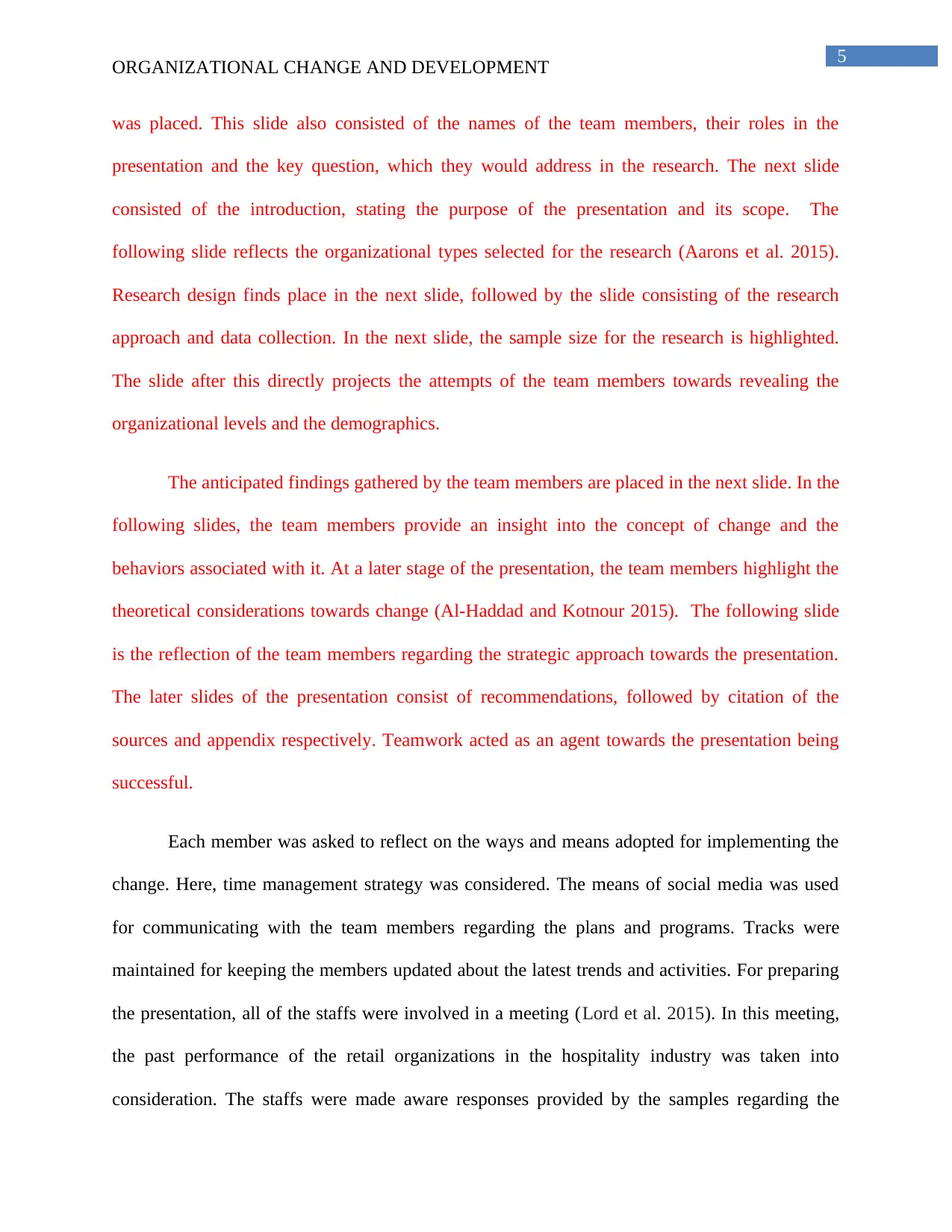
5
ORGANIZATIONAL CHANGE AND DEVELOPMENT
was placed. This slide also consisted of the names of the team members, their roles in the
presentation and the key question, which they would address in the research. The next slide
consisted of the introduction, stating the purpose of the presentation and its scope. The
following slide reflects the organizational types selected for the research (Aarons et al. 2015).
Research design finds place in the next slide, followed by the slide consisting of the research
approach and data collection. In the next slide, the sample size for the research is highlighted.
The slide after this directly projects the attempts of the team members towards revealing the
organizational levels and the demographics.
The anticipated findings gathered by the team members are placed in the next slide. In the
following slides, the team members provide an insight into the concept of change and the
behaviors associated with it. At a later stage of the presentation, the team members highlight the
theoretical considerations towards change (Al-Haddad and Kotnour 2015). The following slide
is the reflection of the team members regarding the strategic approach towards the presentation.
The later slides of the presentation consist of recommendations, followed by citation of the
sources and appendix respectively. Teamwork acted as an agent towards the presentation being
successful.
Each member was asked to reflect on the ways and means adopted for implementing the
change. Here, time management strategy was considered. The means of social media was used
for communicating with the team members regarding the plans and programs. Tracks were
maintained for keeping the members updated about the latest trends and activities. For preparing
the presentation, all of the staffs were involved in a meeting (Lord et al. 2015). In this meeting,
the past performance of the retail organizations in the hospitality industry was taken into
consideration. The staffs were made aware responses provided by the samples regarding the
ORGANIZATIONAL CHANGE AND DEVELOPMENT
was placed. This slide also consisted of the names of the team members, their roles in the
presentation and the key question, which they would address in the research. The next slide
consisted of the introduction, stating the purpose of the presentation and its scope. The
following slide reflects the organizational types selected for the research (Aarons et al. 2015).
Research design finds place in the next slide, followed by the slide consisting of the research
approach and data collection. In the next slide, the sample size for the research is highlighted.
The slide after this directly projects the attempts of the team members towards revealing the
organizational levels and the demographics.
The anticipated findings gathered by the team members are placed in the next slide. In the
following slides, the team members provide an insight into the concept of change and the
behaviors associated with it. At a later stage of the presentation, the team members highlight the
theoretical considerations towards change (Al-Haddad and Kotnour 2015). The following slide
is the reflection of the team members regarding the strategic approach towards the presentation.
The later slides of the presentation consist of recommendations, followed by citation of the
sources and appendix respectively. Teamwork acted as an agent towards the presentation being
successful.
Each member was asked to reflect on the ways and means adopted for implementing the
change. Here, time management strategy was considered. The means of social media was used
for communicating with the team members regarding the plans and programs. Tracks were
maintained for keeping the members updated about the latest trends and activities. For preparing
the presentation, all of the staffs were involved in a meeting (Lord et al. 2015). In this meeting,
the past performance of the retail organizations in the hospitality industry was taken into
consideration. The staffs were made aware responses provided by the samples regarding the
⊘ This is a preview!⊘
Do you want full access?
Subscribe today to unlock all pages.

Trusted by 1+ million students worldwide
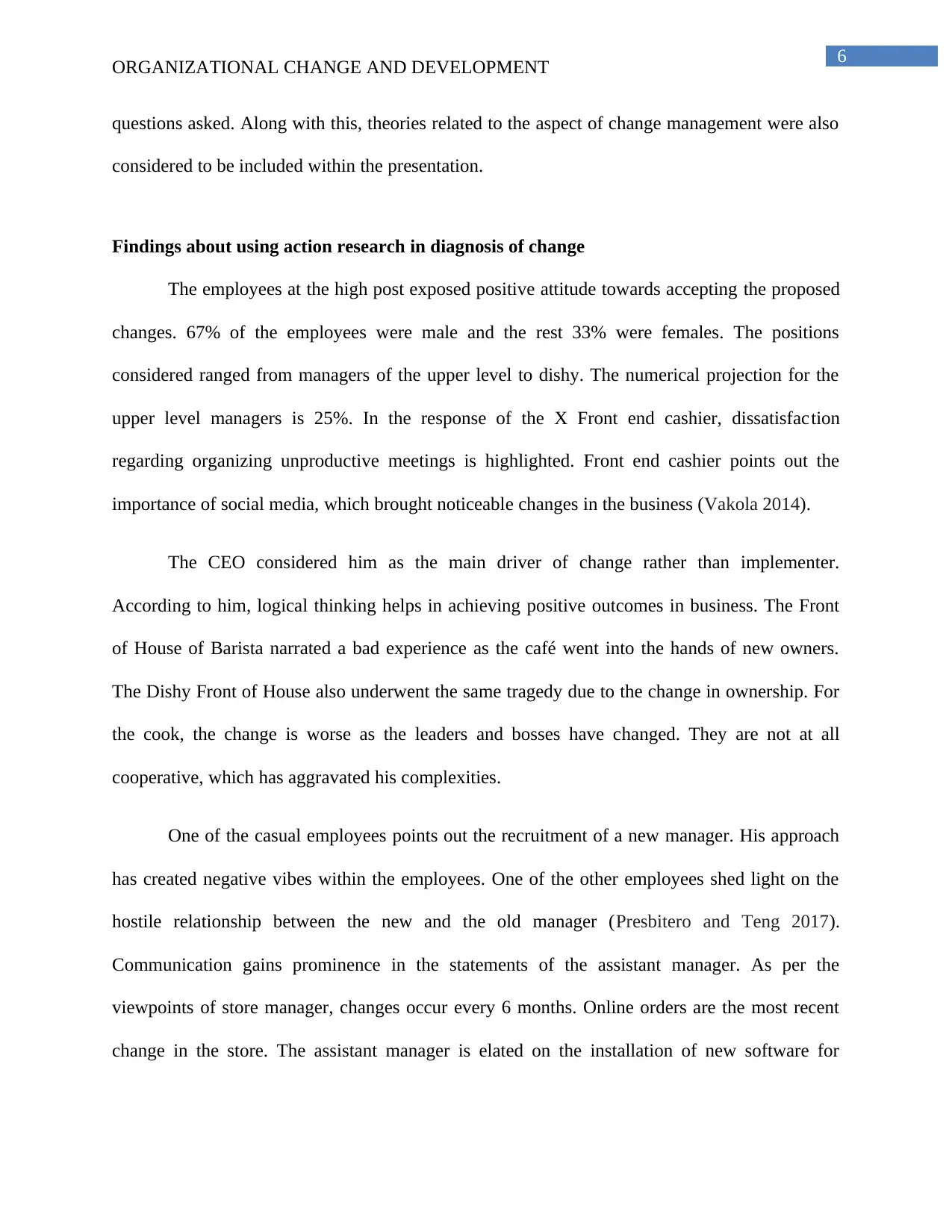
6
ORGANIZATIONAL CHANGE AND DEVELOPMENT
questions asked. Along with this, theories related to the aspect of change management were also
considered to be included within the presentation.
Findings about using action research in diagnosis of change
The employees at the high post exposed positive attitude towards accepting the proposed
changes. 67% of the employees were male and the rest 33% were females. The positions
considered ranged from managers of the upper level to dishy. The numerical projection for the
upper level managers is 25%. In the response of the X Front end cashier, dissatisfaction
regarding organizing unproductive meetings is highlighted. Front end cashier points out the
importance of social media, which brought noticeable changes in the business (Vakola 2014).
The CEO considered him as the main driver of change rather than implementer.
According to him, logical thinking helps in achieving positive outcomes in business. The Front
of House of Barista narrated a bad experience as the café went into the hands of new owners.
The Dishy Front of House also underwent the same tragedy due to the change in ownership. For
the cook, the change is worse as the leaders and bosses have changed. They are not at all
cooperative, which has aggravated his complexities.
One of the casual employees points out the recruitment of a new manager. His approach
has created negative vibes within the employees. One of the other employees shed light on the
hostile relationship between the new and the old manager (Presbitero and Teng 2017).
Communication gains prominence in the statements of the assistant manager. As per the
viewpoints of store manager, changes occur every 6 months. Online orders are the most recent
change in the store. The assistant manager is elated on the installation of new software for
ORGANIZATIONAL CHANGE AND DEVELOPMENT
questions asked. Along with this, theories related to the aspect of change management were also
considered to be included within the presentation.
Findings about using action research in diagnosis of change
The employees at the high post exposed positive attitude towards accepting the proposed
changes. 67% of the employees were male and the rest 33% were females. The positions
considered ranged from managers of the upper level to dishy. The numerical projection for the
upper level managers is 25%. In the response of the X Front end cashier, dissatisfaction
regarding organizing unproductive meetings is highlighted. Front end cashier points out the
importance of social media, which brought noticeable changes in the business (Vakola 2014).
The CEO considered him as the main driver of change rather than implementer.
According to him, logical thinking helps in achieving positive outcomes in business. The Front
of House of Barista narrated a bad experience as the café went into the hands of new owners.
The Dishy Front of House also underwent the same tragedy due to the change in ownership. For
the cook, the change is worse as the leaders and bosses have changed. They are not at all
cooperative, which has aggravated his complexities.
One of the casual employees points out the recruitment of a new manager. His approach
has created negative vibes within the employees. One of the other employees shed light on the
hostile relationship between the new and the old manager (Presbitero and Teng 2017).
Communication gains prominence in the statements of the assistant manager. As per the
viewpoints of store manager, changes occur every 6 months. Online orders are the most recent
change in the store. The assistant manager is elated on the installation of new software for
Paraphrase This Document
Need a fresh take? Get an instant paraphrase of this document with our AI Paraphraser
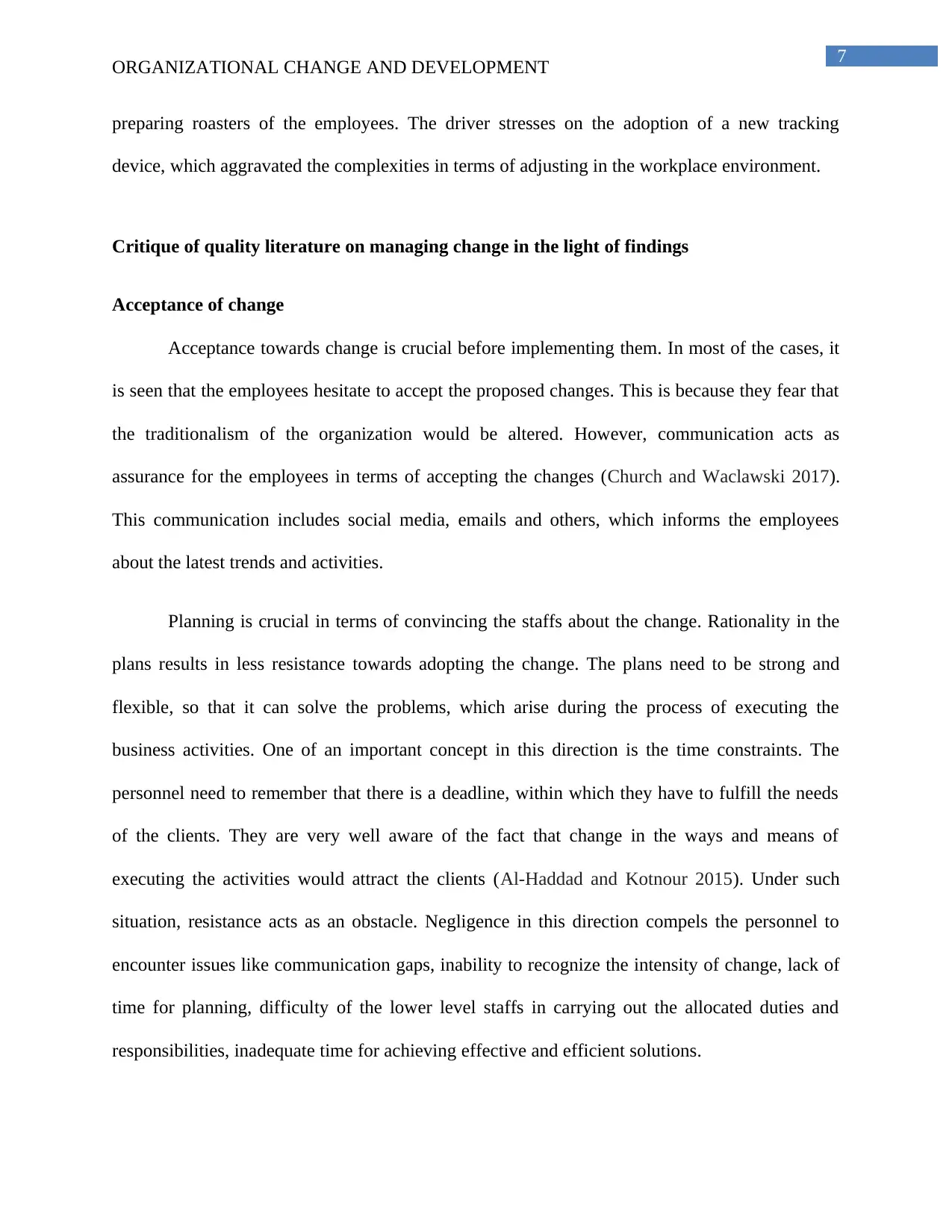
7
ORGANIZATIONAL CHANGE AND DEVELOPMENT
preparing roasters of the employees. The driver stresses on the adoption of a new tracking
device, which aggravated the complexities in terms of adjusting in the workplace environment.
Critique of quality literature on managing change in the light of findings
Acceptance of change
Acceptance towards change is crucial before implementing them. In most of the cases, it
is seen that the employees hesitate to accept the proposed changes. This is because they fear that
the traditionalism of the organization would be altered. However, communication acts as
assurance for the employees in terms of accepting the changes (Church and Waclawski 2017).
This communication includes social media, emails and others, which informs the employees
about the latest trends and activities.
Planning is crucial in terms of convincing the staffs about the change. Rationality in the
plans results in less resistance towards adopting the change. The plans need to be strong and
flexible, so that it can solve the problems, which arise during the process of executing the
business activities. One of an important concept in this direction is the time constraints. The
personnel need to remember that there is a deadline, within which they have to fulfill the needs
of the clients. They are very well aware of the fact that change in the ways and means of
executing the activities would attract the clients (Al-Haddad and Kotnour 2015). Under such
situation, resistance acts as an obstacle. Negligence in this direction compels the personnel to
encounter issues like communication gaps, inability to recognize the intensity of change, lack of
time for planning, difficulty of the lower level staffs in carrying out the allocated duties and
responsibilities, inadequate time for achieving effective and efficient solutions.
ORGANIZATIONAL CHANGE AND DEVELOPMENT
preparing roasters of the employees. The driver stresses on the adoption of a new tracking
device, which aggravated the complexities in terms of adjusting in the workplace environment.
Critique of quality literature on managing change in the light of findings
Acceptance of change
Acceptance towards change is crucial before implementing them. In most of the cases, it
is seen that the employees hesitate to accept the proposed changes. This is because they fear that
the traditionalism of the organization would be altered. However, communication acts as
assurance for the employees in terms of accepting the changes (Church and Waclawski 2017).
This communication includes social media, emails and others, which informs the employees
about the latest trends and activities.
Planning is crucial in terms of convincing the staffs about the change. Rationality in the
plans results in less resistance towards adopting the change. The plans need to be strong and
flexible, so that it can solve the problems, which arise during the process of executing the
business activities. One of an important concept in this direction is the time constraints. The
personnel need to remember that there is a deadline, within which they have to fulfill the needs
of the clients. They are very well aware of the fact that change in the ways and means of
executing the activities would attract the clients (Al-Haddad and Kotnour 2015). Under such
situation, resistance acts as an obstacle. Negligence in this direction compels the personnel to
encounter issues like communication gaps, inability to recognize the intensity of change, lack of
time for planning, difficulty of the lower level staffs in carrying out the allocated duties and
responsibilities, inadequate time for achieving effective and efficient solutions.
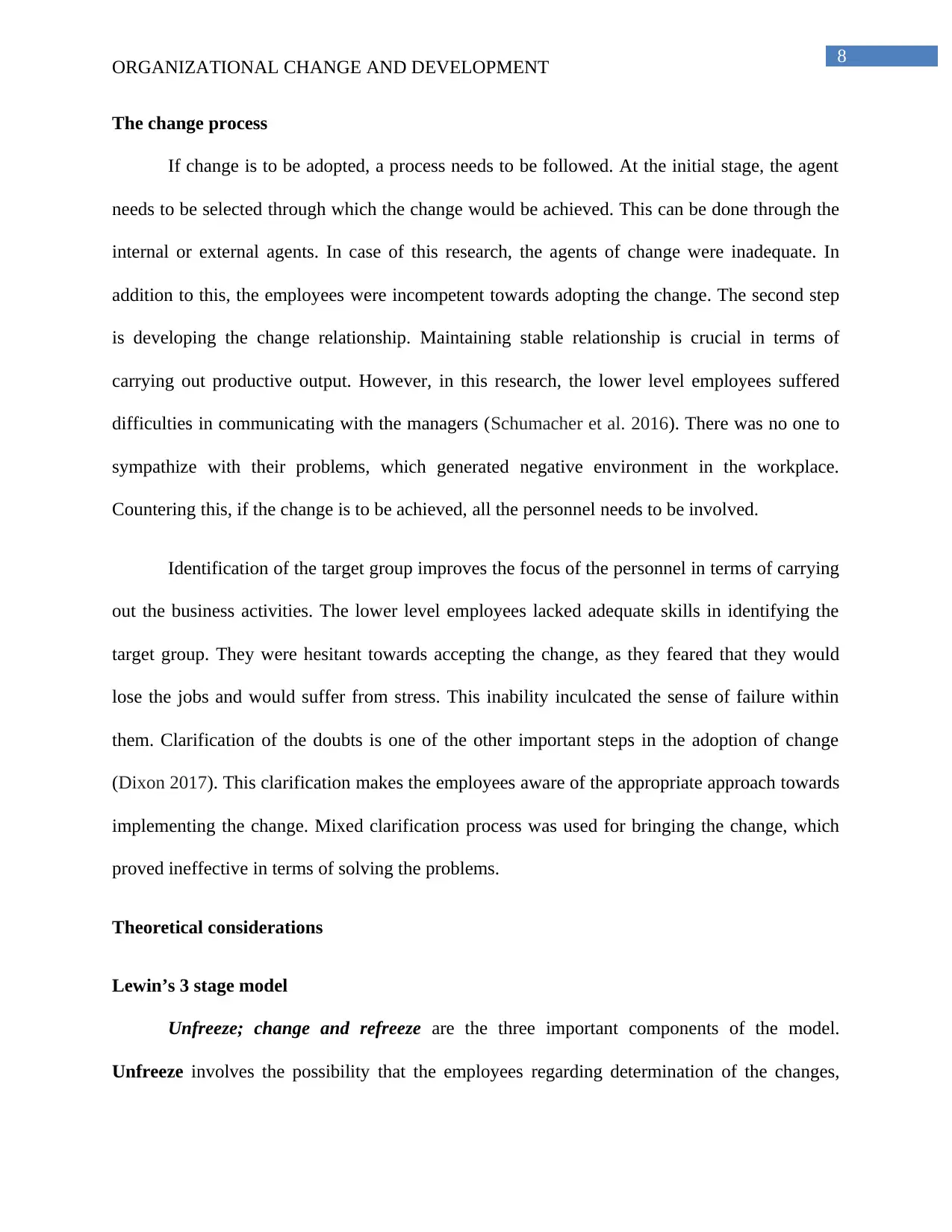
8
ORGANIZATIONAL CHANGE AND DEVELOPMENT
The change process
If change is to be adopted, a process needs to be followed. At the initial stage, the agent
needs to be selected through which the change would be achieved. This can be done through the
internal or external agents. In case of this research, the agents of change were inadequate. In
addition to this, the employees were incompetent towards adopting the change. The second step
is developing the change relationship. Maintaining stable relationship is crucial in terms of
carrying out productive output. However, in this research, the lower level employees suffered
difficulties in communicating with the managers (Schumacher et al. 2016). There was no one to
sympathize with their problems, which generated negative environment in the workplace.
Countering this, if the change is to be achieved, all the personnel needs to be involved.
Identification of the target group improves the focus of the personnel in terms of carrying
out the business activities. The lower level employees lacked adequate skills in identifying the
target group. They were hesitant towards accepting the change, as they feared that they would
lose the jobs and would suffer from stress. This inability inculcated the sense of failure within
them. Clarification of the doubts is one of the other important steps in the adoption of change
(Dixon 2017). This clarification makes the employees aware of the appropriate approach towards
implementing the change. Mixed clarification process was used for bringing the change, which
proved ineffective in terms of solving the problems.
Theoretical considerations
Lewin’s 3 stage model
Unfreeze; change and refreeze are the three important components of the model.
Unfreeze involves the possibility that the employees regarding determination of the changes,
ORGANIZATIONAL CHANGE AND DEVELOPMENT
The change process
If change is to be adopted, a process needs to be followed. At the initial stage, the agent
needs to be selected through which the change would be achieved. This can be done through the
internal or external agents. In case of this research, the agents of change were inadequate. In
addition to this, the employees were incompetent towards adopting the change. The second step
is developing the change relationship. Maintaining stable relationship is crucial in terms of
carrying out productive output. However, in this research, the lower level employees suffered
difficulties in communicating with the managers (Schumacher et al. 2016). There was no one to
sympathize with their problems, which generated negative environment in the workplace.
Countering this, if the change is to be achieved, all the personnel needs to be involved.
Identification of the target group improves the focus of the personnel in terms of carrying
out the business activities. The lower level employees lacked adequate skills in identifying the
target group. They were hesitant towards accepting the change, as they feared that they would
lose the jobs and would suffer from stress. This inability inculcated the sense of failure within
them. Clarification of the doubts is one of the other important steps in the adoption of change
(Dixon 2017). This clarification makes the employees aware of the appropriate approach towards
implementing the change. Mixed clarification process was used for bringing the change, which
proved ineffective in terms of solving the problems.
Theoretical considerations
Lewin’s 3 stage model
Unfreeze; change and refreeze are the three important components of the model.
Unfreeze involves the possibility that the employees regarding determination of the changes,
⊘ This is a preview!⊘
Do you want full access?
Subscribe today to unlock all pages.

Trusted by 1+ million students worldwide
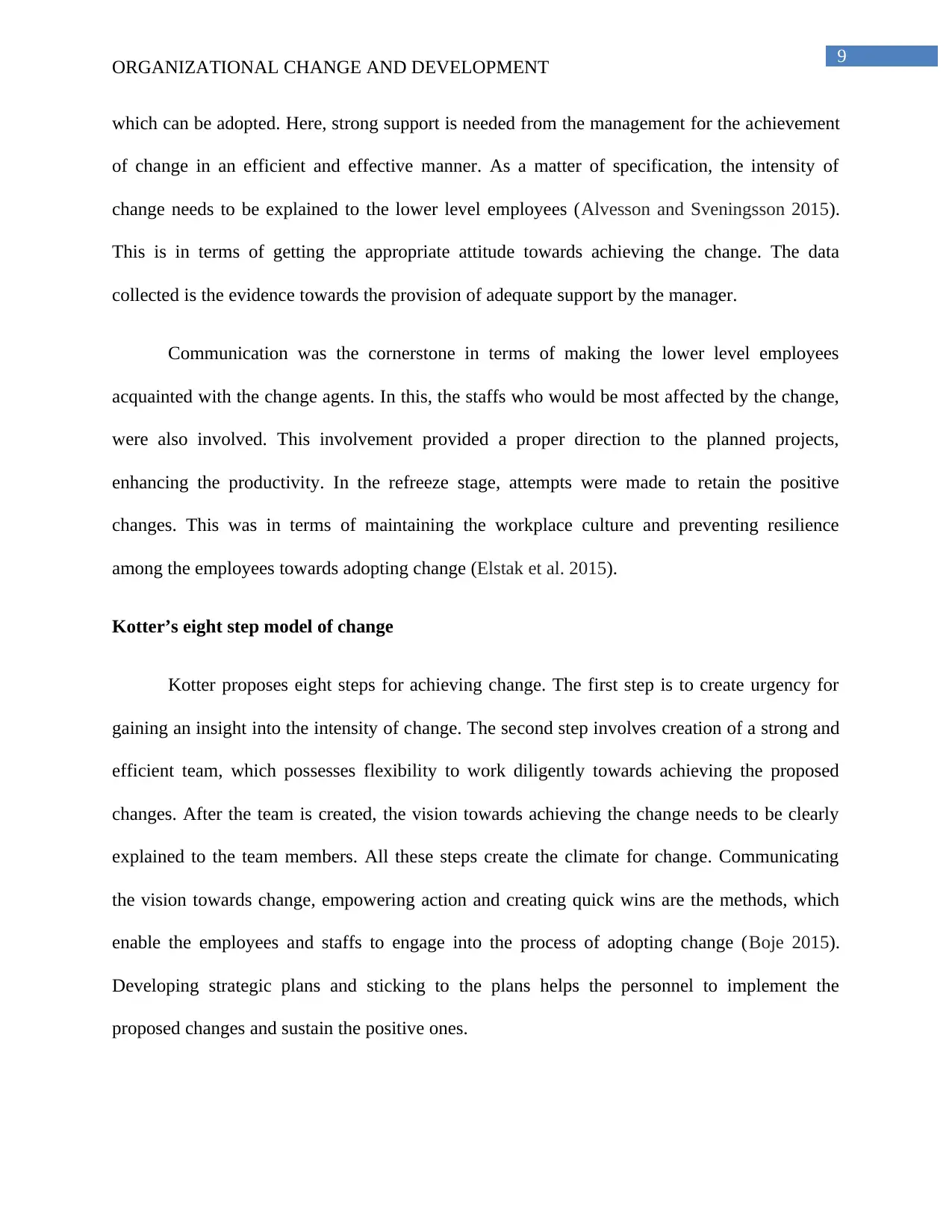
9
ORGANIZATIONAL CHANGE AND DEVELOPMENT
which can be adopted. Here, strong support is needed from the management for the achievement
of change in an efficient and effective manner. As a matter of specification, the intensity of
change needs to be explained to the lower level employees (Alvesson and Sveningsson 2015).
This is in terms of getting the appropriate attitude towards achieving the change. The data
collected is the evidence towards the provision of adequate support by the manager.
Communication was the cornerstone in terms of making the lower level employees
acquainted with the change agents. In this, the staffs who would be most affected by the change,
were also involved. This involvement provided a proper direction to the planned projects,
enhancing the productivity. In the refreeze stage, attempts were made to retain the positive
changes. This was in terms of maintaining the workplace culture and preventing resilience
among the employees towards adopting change (Elstak et al. 2015).
Kotter’s eight step model of change
Kotter proposes eight steps for achieving change. The first step is to create urgency for
gaining an insight into the intensity of change. The second step involves creation of a strong and
efficient team, which possesses flexibility to work diligently towards achieving the proposed
changes. After the team is created, the vision towards achieving the change needs to be clearly
explained to the team members. All these steps create the climate for change. Communicating
the vision towards change, empowering action and creating quick wins are the methods, which
enable the employees and staffs to engage into the process of adopting change (Boje 2015).
Developing strategic plans and sticking to the plans helps the personnel to implement the
proposed changes and sustain the positive ones.
ORGANIZATIONAL CHANGE AND DEVELOPMENT
which can be adopted. Here, strong support is needed from the management for the achievement
of change in an efficient and effective manner. As a matter of specification, the intensity of
change needs to be explained to the lower level employees (Alvesson and Sveningsson 2015).
This is in terms of getting the appropriate attitude towards achieving the change. The data
collected is the evidence towards the provision of adequate support by the manager.
Communication was the cornerstone in terms of making the lower level employees
acquainted with the change agents. In this, the staffs who would be most affected by the change,
were also involved. This involvement provided a proper direction to the planned projects,
enhancing the productivity. In the refreeze stage, attempts were made to retain the positive
changes. This was in terms of maintaining the workplace culture and preventing resilience
among the employees towards adopting change (Elstak et al. 2015).
Kotter’s eight step model of change
Kotter proposes eight steps for achieving change. The first step is to create urgency for
gaining an insight into the intensity of change. The second step involves creation of a strong and
efficient team, which possesses flexibility to work diligently towards achieving the proposed
changes. After the team is created, the vision towards achieving the change needs to be clearly
explained to the team members. All these steps create the climate for change. Communicating
the vision towards change, empowering action and creating quick wins are the methods, which
enable the employees and staffs to engage into the process of adopting change (Boje 2015).
Developing strategic plans and sticking to the plans helps the personnel to implement the
proposed changes and sustain the positive ones.
Paraphrase This Document
Need a fresh take? Get an instant paraphrase of this document with our AI Paraphraser
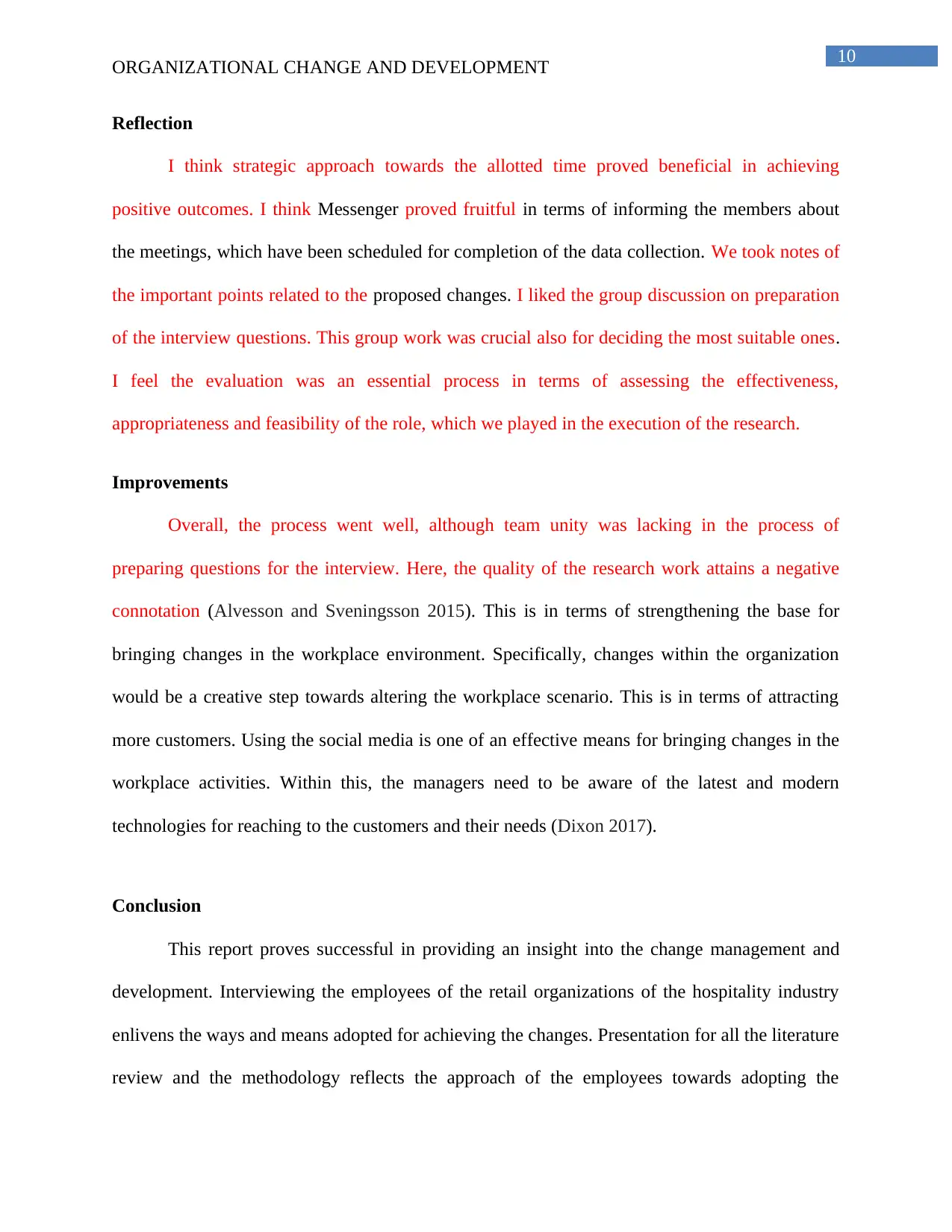
10
ORGANIZATIONAL CHANGE AND DEVELOPMENT
Reflection
I think strategic approach towards the allotted time proved beneficial in achieving
positive outcomes. I think Messenger proved fruitful in terms of informing the members about
the meetings, which have been scheduled for completion of the data collection. We took notes of
the important points related to the proposed changes. I liked the group discussion on preparation
of the interview questions. This group work was crucial also for deciding the most suitable ones.
I feel the evaluation was an essential process in terms of assessing the effectiveness,
appropriateness and feasibility of the role, which we played in the execution of the research.
Improvements
Overall, the process went well, although team unity was lacking in the process of
preparing questions for the interview. Here, the quality of the research work attains a negative
connotation (Alvesson and Sveningsson 2015). This is in terms of strengthening the base for
bringing changes in the workplace environment. Specifically, changes within the organization
would be a creative step towards altering the workplace scenario. This is in terms of attracting
more customers. Using the social media is one of an effective means for bringing changes in the
workplace activities. Within this, the managers need to be aware of the latest and modern
technologies for reaching to the customers and their needs (Dixon 2017).
Conclusion
This report proves successful in providing an insight into the change management and
development. Interviewing the employees of the retail organizations of the hospitality industry
enlivens the ways and means adopted for achieving the changes. Presentation for all the literature
review and the methodology reflects the approach of the employees towards adopting the
ORGANIZATIONAL CHANGE AND DEVELOPMENT
Reflection
I think strategic approach towards the allotted time proved beneficial in achieving
positive outcomes. I think Messenger proved fruitful in terms of informing the members about
the meetings, which have been scheduled for completion of the data collection. We took notes of
the important points related to the proposed changes. I liked the group discussion on preparation
of the interview questions. This group work was crucial also for deciding the most suitable ones.
I feel the evaluation was an essential process in terms of assessing the effectiveness,
appropriateness and feasibility of the role, which we played in the execution of the research.
Improvements
Overall, the process went well, although team unity was lacking in the process of
preparing questions for the interview. Here, the quality of the research work attains a negative
connotation (Alvesson and Sveningsson 2015). This is in terms of strengthening the base for
bringing changes in the workplace environment. Specifically, changes within the organization
would be a creative step towards altering the workplace scenario. This is in terms of attracting
more customers. Using the social media is one of an effective means for bringing changes in the
workplace activities. Within this, the managers need to be aware of the latest and modern
technologies for reaching to the customers and their needs (Dixon 2017).
Conclusion
This report proves successful in providing an insight into the change management and
development. Interviewing the employees of the retail organizations of the hospitality industry
enlivens the ways and means adopted for achieving the changes. Presentation for all the literature
review and the methodology reflects the approach of the employees towards adopting the
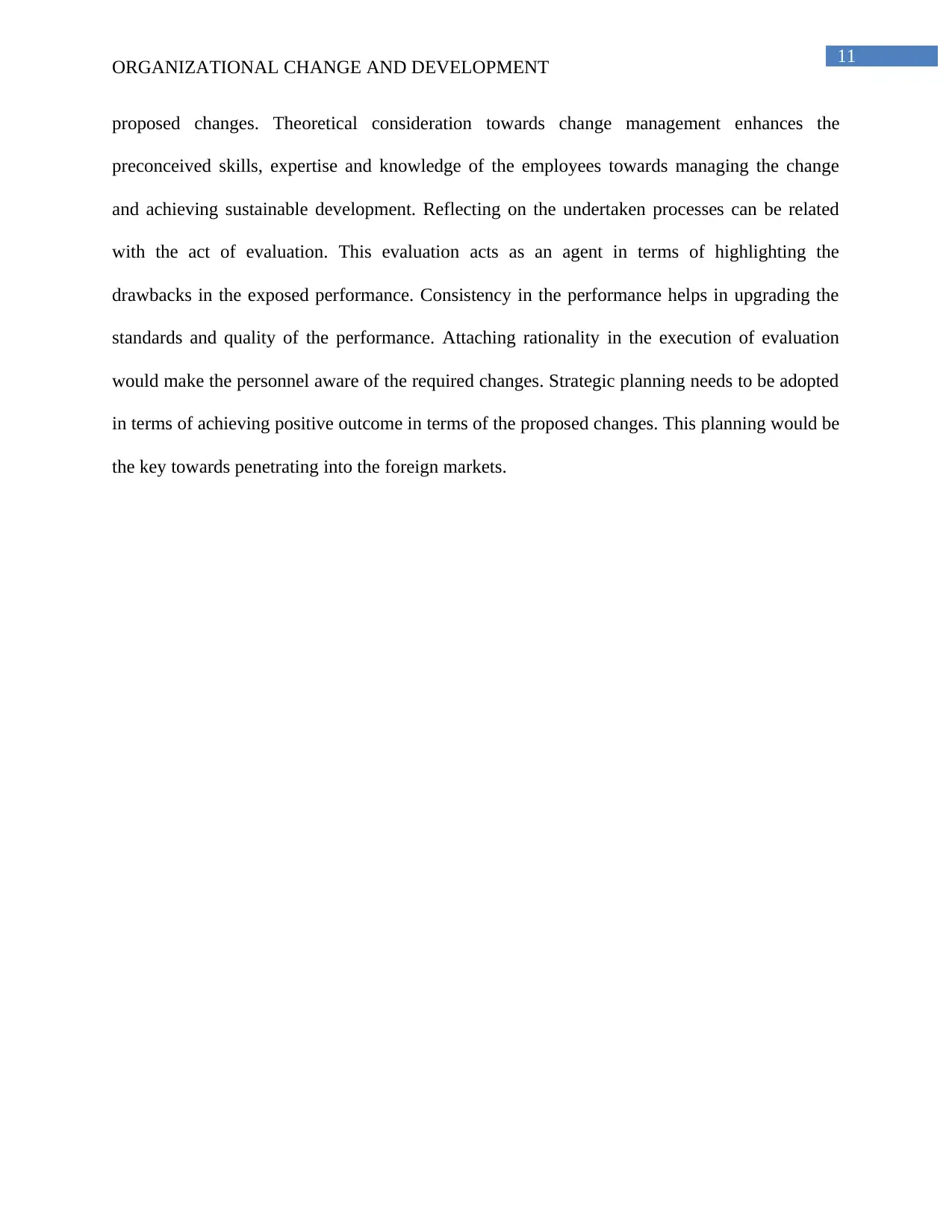
11
ORGANIZATIONAL CHANGE AND DEVELOPMENT
proposed changes. Theoretical consideration towards change management enhances the
preconceived skills, expertise and knowledge of the employees towards managing the change
and achieving sustainable development. Reflecting on the undertaken processes can be related
with the act of evaluation. This evaluation acts as an agent in terms of highlighting the
drawbacks in the exposed performance. Consistency in the performance helps in upgrading the
standards and quality of the performance. Attaching rationality in the execution of evaluation
would make the personnel aware of the required changes. Strategic planning needs to be adopted
in terms of achieving positive outcome in terms of the proposed changes. This planning would be
the key towards penetrating into the foreign markets.
ORGANIZATIONAL CHANGE AND DEVELOPMENT
proposed changes. Theoretical consideration towards change management enhances the
preconceived skills, expertise and knowledge of the employees towards managing the change
and achieving sustainable development. Reflecting on the undertaken processes can be related
with the act of evaluation. This evaluation acts as an agent in terms of highlighting the
drawbacks in the exposed performance. Consistency in the performance helps in upgrading the
standards and quality of the performance. Attaching rationality in the execution of evaluation
would make the personnel aware of the required changes. Strategic planning needs to be adopted
in terms of achieving positive outcome in terms of the proposed changes. This planning would be
the key towards penetrating into the foreign markets.
⊘ This is a preview!⊘
Do you want full access?
Subscribe today to unlock all pages.

Trusted by 1+ million students worldwide
1 out of 15
Related Documents
Your All-in-One AI-Powered Toolkit for Academic Success.
+13062052269
info@desklib.com
Available 24*7 on WhatsApp / Email
![[object Object]](/_next/static/media/star-bottom.7253800d.svg)
Unlock your academic potential
Copyright © 2020–2025 A2Z Services. All Rights Reserved. Developed and managed by ZUCOL.





